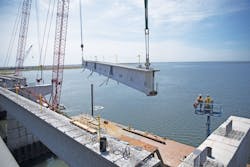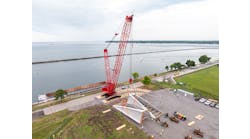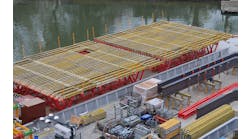By: Bill Wilson
The bridge industry likes to celebrate progress with fireworks. The most recent development is worth about a box of sparklers. The reaction is not quite as strong, but it is still nice to experience.
According to the American Road and Transportation Builders Association (ARTBA), the number of structurally deficient bridges in the U.S. went down in 2015—there were 2,574 fewer than in 2014—and momentum might actually build following the passage of the Fixing America’s Surface Transportation Act, or FAST Act, and a continued transportation funding revival at the state level. With each new bridge, complete with the grand opening pyrotechnics, there are dozens and dozens of rehabs taking place.
“[The number of structurally deficient bridges] is still way too big a number but it is trending in the right direction,” Rob Turton, HNTB Corp.’s National Bridge Practice Leader, told Roads & Bridges. “Are they doing all they can to take bridges off the structurally deficient list? I would say we are never doing all we can, but we may be doing all that is practical.”
There could be a giant wave of aging bridges about to crash on this small party, a surge that would dry up industry adrenaline. It is an ongoing battle, one where the good side has the upper hand—at least for the time being.
“I can appreciate how you can look at it and say, well, that doesn’t look like that much,” David Anderson, deputy chief engineer of design for the Massachusetts Department of Transportation (MassDOT), told Roads & Bridges when addressing the progress in his state where the number of structurally deficient bridges under the Accelerated Bridge Program has gone down from 543 in 2008 to 428, “but as you probably know the challenge is [that] bridges are always being added to the inventory of structurally deficient bridges, so it is trying to stay ahead of the rate that they come on. That is what is problematic.”
According to the latest Roads & Bridges Bridge Survey, the struggle is real. Just over 25% of respondents said the number of structurally deficient bridges went up in 2015, and almost the same number (26.1%) indicated the number went down. About 50% said the number remained the same. As far as funding goes, 30% said the bridge maintenance/construction budget increased last year, while 21% said it decreased. Again, about half reported no change.
So perhaps the FAST Act, which will fund the road and bridge industry for the next five years at a $305 billion clip, will indeed help sustain this positive vibe. Most experts Roads & Bridges interviewed believe the commitment of federal dollars will do just that, but while state DOTs have tended to their bridge dilemma the overall condition of pavements has suffered. It is unclear if more FAST Act money will be used to address local roads and highways.
“The states and local governments have put so much money towards bridge work, we would expect to see that continued improvement,” Alison Premo Black, chief economist at ARTBA, told Roads & Bridges, “but I think there is a tradeoff when we look at the pavement market; I think some of that bridge work is coming at the expense of the pavement side.”
Some massive bridge improvement efforts also are starting to come to an end. Missouri’s Safe and Sound Bridge Program took over 800 bridges off of the structurally deficient list, and MassDOT’s Accelerated Bridge Program is down to its final contract. Pennsylvania’s Rapid Bridge Replacement Project is currently in full swing and has a goal of addressing 558 aging bridges.
“[States] can only address so many bridges per year given their limited resources,” Tom Zink, bridge practice leader for Gannett Fleming, told Roads & Bridges. “The process itself can’t be stopped and a vast majority of bridges that are not being repaired or replaced will continue to deteriorate. Construction has come in cycles over the history of our country so we can expect the need for rehabilitation to come in similar cycles.”
To reach the ultimate goal of 140 structurally deficient bridges, New Jersey will have to average at least $750 million a year in funding for bridge improvements.
Staying in shape
When it comes to transportation funding, Florida has been on a very productive cycle. It is near the top of the nation’s bridge condition index, and the state is not solely reliant on the gas tax. Other revenue generators, like the vehicle registration fee, come into play, and the region’s economy is outpacing the national average.
“That diversity has insulated us from some of the ups and downs with the gas tax,” Jim Boxold, Florida’s Secretary of Transportation, told Roads & Bridges.
“We have also over the generations been very aggressive with things like construction specs, so our bridges are built very well considering a vast majority are standing in salt water,” Tom Byron, assistant secretary for Florida’s Intermodal Systems Development, told Roads & Bridges.
The road and bridge industry in Florida now has another leg to stand on following the passage of HB 7027, which was signed into law by Gov. Rick Scott in early April. The legislation creates a financing corporation that will build major projects more competitively and at lower interest rates, thus delivering transportation improvements quicker and more efficiently. The Florida Department of Transportation Financing Corp. somewhat resembles Florida’s state infrastructure bank, which is used for non-transportation-related projects. According to Byron, in most cases gap financing will be the driving funding force, where future road program dollars are used for repayments. It follows the public-private partnership program (P3) already in place. Florida has done around 15 P3s, and three of them are mega road and bridge projects.
“This will be another way to bring additional dollars into that conversation,” said Byron. “We are in the process now of identifying candidate projects for the first couple to try it out.”
Christie’s fight
When Chris Christie was elected governor of New Jersey, one of his first orders of business was to address a bridge network that was severely handicapped. The goal was to cut the number of structurally deficient bridges in half, and so far over $4 billion has dropped the level to about 290. To reach the ultimate goal of around 140, New Jersey will have to average at least $750 million a year in funding for bridge improvements. The pot was $651 million for FY 2016, and that includes work that needs to be done at the local level. Some years the funding level has been as high as $800 million. The passage of the FAST Act will give the New Jersey DOT an additional $200 million annually to work into the crusade, but some of that money will be used to address deteriorating pavement.
“There is still a lot of work to be done,” Greg Renman, manager, Structural Evaluation & Bridge Management, for the New Jersey DOT, told Roads & Bridges. “We are improving bridges and taking them off the list but you have more bridges that become structurally deficient each year so it’s a challenge to make that improvement. We have done a good job over the years to reach [290].”
Currently the state’s biggest project is the 3.5-mile, $1 billion Pulaski Skyway rehabilitation. The bridge portion of the project was built in 1932 and still has the original concrete deck, which will be completely replaced. Superstructure and substructure work also will take place.
Another project that involves erasing a bridge from the structurally deficient list is going on in Ocean County. At the center of it all is the Rte. 72 Manahawkin Bay Bridge, a pin-and-hangar structure that is non-redundant and has been hit with fatigue cracking and corrosion. Plans call for a new bridge to be constructed next to the old one, which will have its foundations rehabilitated and superstructure replaced.
Trying to catch a second wind
MassDOT’s Accelerated Bridge Program is slowing to a stop, but another plan just might be getting a green light. Since 2008, the Accelerated Bridge Program has taken 115 bridges off the structurally deficient list, and the state is now in the process of putting together a five-year capital improvement plan that would provide $400 million annually for bridge work.
Anderson expects the FAST Act to only have a minor impact on MassDOT’s effort to strengthen its elevated network.
“What we are looking to do with state funding is a lot of preservation activities and focused repairs to try to prevent bridges from becoming structurally deficient,” he said.
MassDOT also is looking to establish a program where municipalities would receive state funding to address deficient bridges with spans that come in under 20 ft in length. Money would come via the state bond cap.
Ready to fly?
Nationwide, accelerated bridge construction is at an all-time high, and more agencies are using precast construction as a way of addressing a problem by using the shortest possible schedule.
Unmanned aerial vehicles (UAVs) have received a load of attention as of late; they fit the “fix-it-fast” mode the industry is currently embracing. Feelings from state DOTs are mixed. The New Jersey DOT is not looking into using UAVs, and instead has joined Rutgers University in taking a look at the potential of robotic equipment.
“They can do it quicker, they can do it cheaper,” Dave Lambert, assistant commissioner, Capital Program Management, for the New Jersey DOT, told Roads & Bridges.
Florida is working with the University of Florida on UAV use, and MassDOT is aware of the technology but has not starting talking about any sort of implementation.
When Roads & Bridges’ readers were asked about UAV use, 97% said their state DOT currently does not use UAVs, and 71% did not see it happening in the near future.
Some combination of human/UAV inspection will most likely be the way most DOTs carry it out.
“You are never going to eliminate the brain,” said Turton, “but I think it is a phenomenal tool that has great promise in bridge inspection. You can go from periodic inspections to full-time, 24/7 type of inspections.”
About The Author: Wilson is Editorial Director for Roads & Bridges




